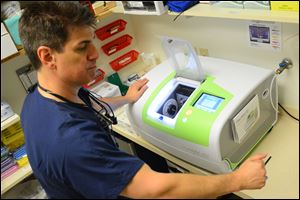
Dentists benefit from 3-D technology
New process drops wait for crowns from weeks to hours
6/8/2015
Dentist Rick Rivardo operates a Plan Mill milling unit at his office in Monroeville, Pa.
MONROEVILLE, Pa. — Most people dread going to the dentist to get a crown on one of their teeth.
The procedure can be long, tedious and often uncomfortable. Once in the chair, patients must bite down on a putty-like material — which can trigger the gag reflex — to create an impression of their teeth. Patients must wear temporary crowns for a few weeks until their permanent crowns have been made from the impressions, sometimes returning to the office for corrections if one falls out or is uncomfortable.
Traditionally, crown fittings take three weeks and multiple visits to the dentist to complete. These permanent tooth-shaped “caps” — made of durable material such as steel, porcelain, or ceramic — are put on to protect a weak tooth, restore a broken tooth, cover and support a tooth with a large filling, or serve other uses.
But, this clunky, gooey, and slow process may soon be history in most dental offices.
New 3-D video imaging technology is speeding up the time it takes for dentists to create lab-quality dental restorations — from weeks to a couple of hours.
Computer-aided design and computer-aided manufacturing — known as CAD/CAM technology — consists of a scanning wand no bigger than a large toothbrush, and an on-site milling machine.
The new system allows dentists to create and insert crowns, inlays, onlays, and veneers in a single appointment. The scanning wand takes a 3-D image or video of a dental region in as little as 15 seconds.
A block of a durable material such as lithium disilicate is then milled into shape and baked before it is inserted into the patient’s mouth.
“There’s always the sense of amazement when patients experience [CAD/CAM technology] for the first time,” said Jeffery Verner, a dentist in Bethel Park. “I’ve even had some patients put the block in the machine themselves, and others call back afterward saying it was a cool experience.”
Christine Trice, office manager for dentist Rick Rivardo in Monroeville, Pa., said that the condensed time makes it easier for working people to better care for their teeth. Finding time in patients’ schedules for several appointments is the main reason treatment is delayed or even avoided, she said.
Sandy Hazel, 60, who had 10 crowns replaced in fewer than two years, agreed. Ms. Hazel works full time as an office manager in a Pittsburgh gynecology practice. With three crowns fitted per day, she was able to replace her crowns and miss few days of work. The traditional method would require at least 20 visits for 10 crown fittings.
“I had all mine done in five visits,” Ms. Hazel said.
Ms. Trice said because the new technology eliminates the need for putting in temporary crowns, there is also a reduced risk of irritation and increased tooth sensitivity.
Harve Dailey, 63, a retired chemist who has a rare nickel allergy, said that the technology has spared him from the severe gum irritation and bleeding he had with his old crowns. “This new procedure is much better from a patient point of view,” he said.
Despite these advantages, use of the new technology is not yet the standard in most Allegheny County dental practices, said Charles Sfeir, director of the Center for Craniofacial Regeneration at the University of Pittsburgh School of Dental Medicine.
While the cost to patients using this technology does not change compared with the traditional approach, dental practices must pay roughly $100,000 for the equipment. Additional training also is needed to operate the new devices, which may dissuade some older practitioners from adopting it, Ms. Trice said.
Still, a growing number of dental practices the Pittsburgh area are making the investment.
Meredith Fennell, a dentist in Chicora, has had the equipment for nearly two years, and Mr. Rivardo, the Monroeville dentist, introduced it earlier this month. Pitt dental students have been getting training on the new equipment over the past few years, Mr. Sfeir said.
“I don’t think a lot of people know about this,” he said. “We really are moving into the digital era and increasing convenience for patients.”
The Block News Alliance consists of The Blade and the Pittsburgh Post-Gazette. Amaka Uchegbu is a reporter for the Post-Gazette.